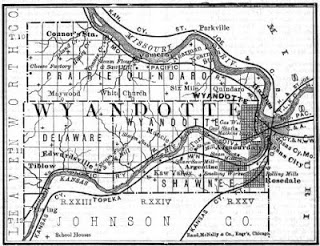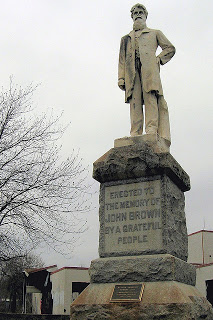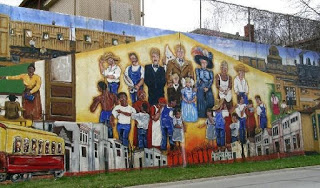Medicine

 KCK was incorporated early in the 20th century, combining a number of independent towns, most based around a primary industry, and sometimes even named for it (Argentine, home of a silver smelter, and Armourdale, where there was a meat-packing plant). Much of its history – and present – is determined by its border with Missouri; even today, living in this metropolitan area is greatly affected by being in two states. The Missouri River divides Missouri and Kansas south to Kansas City, where it turns east toward St. Louis, and most of the border between the two states is a two lane street. Quindaro, in the northeast part of the city, is on the Missouri River; it was settled by African-American slaves who crossed the river from Parkville, MO, and, after being dragged south by the current, coming out in the free state of Kansas. Quindaro was a major underground railroad center, and the ruins of the original settlement are now an archeological site, with a statue of John Brown on what was the campus of Western University. The current Quindaro neighborhood is overwhelmingly Black and poor.
KCK was incorporated early in the 20th century, combining a number of independent towns, most based around a primary industry, and sometimes even named for it (Argentine, home of a silver smelter, and Armourdale, where there was a meat-packing plant). Much of its history – and present – is determined by its border with Missouri; even today, living in this metropolitan area is greatly affected by being in two states. The Missouri River divides Missouri and Kansas south to Kansas City, where it turns east toward St. Louis, and most of the border between the two states is a two lane street. Quindaro, in the northeast part of the city, is on the Missouri River; it was settled by African-American slaves who crossed the river from Parkville, MO, and, after being dragged south by the current, coming out in the free state of Kansas. Quindaro was a major underground railroad center, and the ruins of the original settlement are now an archeological site, with a statue of John Brown on what was the campus of Western University. The current Quindaro neighborhood is overwhelmingly Black and poor.

- Medicaid Expansion And Uncovered Lives: Are People Meaner In The South?
I have lived in a number of places, from New York City to Texas, Illinois to Kansas. Politically and socially there are very different norms that prevail, which are demonstrated by the difference in who we elect and what policies we choose to legislate....
- Kansas Only State To Increase Number Of Uninsured: A How Not To Do It Strategy
The title of Alan Bavley’s article, “Kansas is only state to see an increase in its uninsured rate, survey says”, (Kansas City Star, August 5, 2014) kind of says it all. It could be seen as a victory by some. Four years after the passage of the...
- Medicaid Expansion: Do We Care For People Or Not?
A cornerstone of the health coverage reforms in the 2010 Affordable Care Act (ACA) was the expansion of Medicaid to a large population currently ineligible for this benefit. This was intended to cover those who work but have low wage jobs that neither...
- Kansas, Medicaid Expansion, And Human Rights
In his well-covered “state of the state” speech, the Governor of Kansas, Sam Brownback (full text from the Lawrence Journal World, reported by the Kansas City Star or as you prefer either the Huffington Post’s reporting of it or the Kansas City...
- Community Health Centers
Boxing Day, December 26, 2008, the New York Times has a shortage of news, and its featured right-hand column page 1 story is “For Bush, a rise in health clinics shapes a legacy”. While scarcely “news”, the article addresses an important topic:...
Medicine
Latinos and health care in Kansas City, Kansas

Kansas City, Kansas, where I live, makes up the bulk of Wyandotte County. It is the poorest county in Kansas, with a large number of low-income residents of all ethnicities, and stands in many ways in stark contrast to Johnson County to its south, Kansas’ richest county. It is not as poor or depressed as Camden, NJ (see February 18, 2012 blog, Camden and you: the cost of health care to communities); while it has lost many blue-collar industrial jobs, a large number still remain in its Fairfax industrial district (including a GM plant) and along the two enormous trainyards in town. Many of the workers in those plants no longer live in KCK (as the city is known to distinguish it from KCMO). It is seen as a regional “success story” because of the development in the western part of the county around the NASCAR track (and now including a huge mall with Cabela’s, Nebraska Furniture Mart, and a new professional soccer stadium). However, all occurred with tax abatements from the county, so people’s property tax assessments are very high because the value of the real estate is low.
 KCK was incorporated early in the 20th century, combining a number of independent towns, most based around a primary industry, and sometimes even named for it (Argentine, home of a silver smelter, and Armourdale, where there was a meat-packing plant). Much of its history – and present – is determined by its border with Missouri; even today, living in this metropolitan area is greatly affected by being in two states. The Missouri River divides Missouri and Kansas south to Kansas City, where it turns east toward St. Louis, and most of the border between the two states is a two lane street. Quindaro, in the northeast part of the city, is on the Missouri River; it was settled by African-American slaves who crossed the river from Parkville, MO, and, after being dragged south by the current, coming out in the free state of Kansas. Quindaro was a major underground railroad center, and the ruins of the original settlement are now an archeological site, with a statue of John Brown on what was the campus of Western University. The current Quindaro neighborhood is overwhelmingly Black and poor.
KCK was incorporated early in the 20th century, combining a number of independent towns, most based around a primary industry, and sometimes even named for it (Argentine, home of a silver smelter, and Armourdale, where there was a meat-packing plant). Much of its history – and present – is determined by its border with Missouri; even today, living in this metropolitan area is greatly affected by being in two states. The Missouri River divides Missouri and Kansas south to Kansas City, where it turns east toward St. Louis, and most of the border between the two states is a two lane street. Quindaro, in the northeast part of the city, is on the Missouri River; it was settled by African-American slaves who crossed the river from Parkville, MO, and, after being dragged south by the current, coming out in the free state of Kansas. Quindaro was a major underground railroad center, and the ruins of the original settlement are now an archeological site, with a statue of John Brown on what was the campus of Western University. The current Quindaro neighborhood is overwhelmingly Black and poor. Latinos, mostly from Mexico, arrived in 3 waves. The first came to help build the railroads that have been so central to KCK, the second to work in the silver smelter, and the most recent, as in so many US cities over the last 10-20 years, looking for any kind of jobs. 70% of the population increase in Kansas from 2000 to 2010 was Latino; while there are other concentrations, especially in southwest Kansas where there are meatpacking plants and the first majority-minority counties in the state, KCK is definitely a center for Mexican-Americans. The new Latino population is overflowing the boundaries of the traditional Hispanic community, the Argentine (a little confusing, as it is named for silver, not the country of origin of its Spanish-speaking majority), to cover much of the city. A huge mural portrays the history of Argentine, including the migrations of blacks and Latinos and the “clash of cultures” seen in the segment reproduced here.

The Latino community of KCK, like others, suffers the health problems associated with poverty, with young families, and with chronic diseases. The youth of this population means that pregnancy and childbirth, and well-child care, are a dominant health need. Diabetes is very common in the community. And many people do not have good health care access. Most of the industries in town are small, and do not offer health insurance, or offer it with very high premiums, copayments and deductibles. At a time when the National Business Group for Health, representing mostly Fortune 500 companies whose employees have the best health insurance, is predicting big increases in employee premiums, copayments, and deductibles, workers at small companies will be harder hit. And, of course, a large portion of Latino workers are undocumented, and thus ineligible for insurance, although most pay taxes. Even their children, who should be eligible for Medicaid or SCHIP, often do not have coverage because their parents are afraid to enroll them. This is not an idle worry in a state whose legislature is trying to deny in-state tuition at its public universities to students who are legal citizens and residents, often born here, but whose parents are undocumented.
As the poorest county in Kansas, Wyandotte County also has the poorest health status in rankings of Kansas’ 105 counties by the Kansas Health Institute in 2009. In national health rankings by the Robert Wood Johnson Foundation in 2011, Wyandotte County came in at 95 – because there was no data for 10 of the state’s smaller counties. As recently as February, 2012, the Community Dashboard published by Kansas Health Matters, continues, unsurprisingly, to show major health challenges. These go far beyond access to medical care to include the entire gamut of the social determinants of health. Access to preventive care and to early diagnosis and treatment of disease is important, but so is having a place to live. And enough heat in the winter. And enough food to eat. And a safe neighborhood, and safe housing. Often providers decry patients missing their appointments; a recent home visit by a health worker found the steps to be so rotten in front of the house of one such patient that it was lucky they didn’t try to come in – they likely would have fallen and broken their hip.
But access to medical care is an important component of health, and it is limited for residents of KCK. Being in Kansas, there are no publicly funded hospitals (there is one across the state line in Kansas City, MO); there are no publicly funded clinics (as there are in San Antonio, TX, where I used to live). There is no state, county, or municipal funding to provide health care to the uninsured and underserved, not in Wyandotte County or even in the very wealthy (but still with a large number of poor, including Latino poor, residents) Johnson County. The Affordable Care Act (ACA) promises to increase the number of Americans with insurance, and will make a large difference for many, but will be far from a solution to the issues confronting Latinos in KCK.
First, of course, undocumented people will still not be covered. Then, much of the increase in coverage for the poor will be in the form of expanded Medicaid eligibility, largely funded by the federal government, in 2014. Of course, this depends on finding providers who will accept Medicaid rates. Many of the Latino and other workers in KCK work for companies too small to be required to provide coverage. People who are not Medicaid eligible or undocumented may be offered the opportunity to purchase insurance, or required to if the “individual mandate” is ruled legal by the Supreme Court, but are not likely to be able to afford quality coverage. We read a lot about “quality of care”, but “quality of coverage” is also important – not all insurance is the same. There are often high premiums, co-payments, and deductibles and also low maximal coverage limits. ACA will help to some degree, but many of our people will be left out in the cold.
KCK has a number of “safety net” clinics, if no publicly funded ones. There are a couple of branches of a Missouri-based Federally-Qualified Health Center (FQHC), but these depend on the higher reimbursement they receive from Medicare and Medicaid; recently the one in the Quindaro moved several miles further west, to a neighborhood with more of these government-insured patients. This was better for their business plan than staying in a neighborhood full of uninsured people, but it left Northeast KCK with no doctors. Luckily, another safety-net, which doesn’t get increased Medicare/Medicaid reimbursement and depends on both grants and paying everyone (including the doctors) $14/h, opened a branch in the community. So, at least, there are community organizations, like these clinics, and the student-run free clinic, and Latino community service agencies, to help. But the need is far greater.
And, of course, like elsewhere, there are not enough primary care providers, especially with the new people to be covered under ACA. This is documented in a recent Washington Post piece “Success of health reform hinges on hiring 30,000 primary care doctors by 2015”. Of course, to “hire” them, they have to exist. Which means training them. Which means paying them enough, compared to other specialists, that medical students choose to enter them.
The health problems faced by Latinos in Kansas City, KS, are not unique. But they are serious. And they demand serious solutions, to be confronted by the city, county and state as well as the federal government and insurance companies. And that is yet to happen.
- Medicaid Expansion And Uncovered Lives: Are People Meaner In The South?
I have lived in a number of places, from New York City to Texas, Illinois to Kansas. Politically and socially there are very different norms that prevail, which are demonstrated by the difference in who we elect and what policies we choose to legislate....
- Kansas Only State To Increase Number Of Uninsured: A How Not To Do It Strategy
The title of Alan Bavley’s article, “Kansas is only state to see an increase in its uninsured rate, survey says”, (Kansas City Star, August 5, 2014) kind of says it all. It could be seen as a victory by some. Four years after the passage of the...
- Medicaid Expansion: Do We Care For People Or Not?
A cornerstone of the health coverage reforms in the 2010 Affordable Care Act (ACA) was the expansion of Medicaid to a large population currently ineligible for this benefit. This was intended to cover those who work but have low wage jobs that neither...
- Kansas, Medicaid Expansion, And Human Rights
In his well-covered “state of the state” speech, the Governor of Kansas, Sam Brownback (full text from the Lawrence Journal World, reported by the Kansas City Star or as you prefer either the Huffington Post’s reporting of it or the Kansas City...
- Community Health Centers
Boxing Day, December 26, 2008, the New York Times has a shortage of news, and its featured right-hand column page 1 story is “For Bush, a rise in health clinics shapes a legacy”. While scarcely “news”, the article addresses an important topic:...
